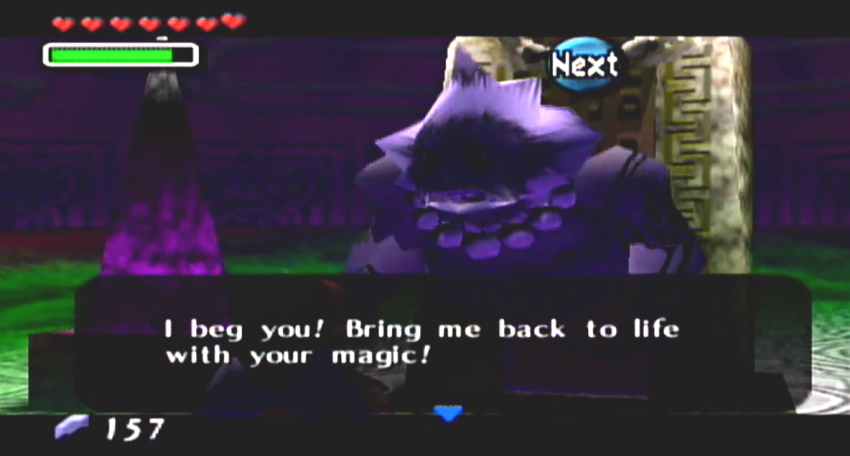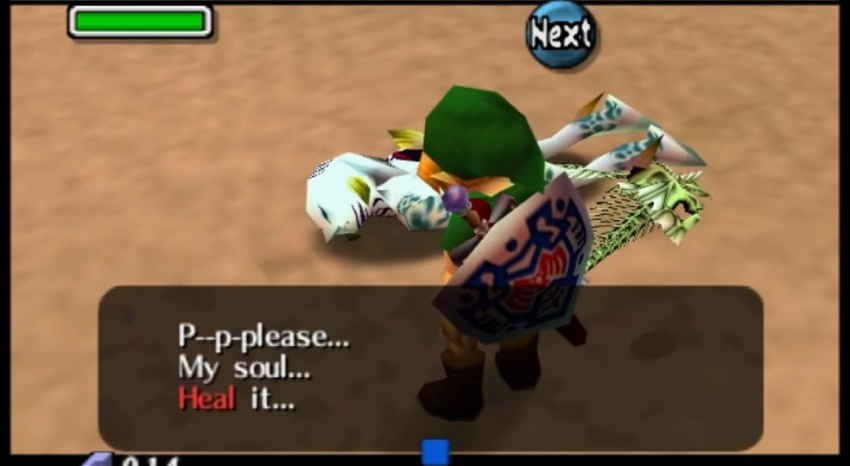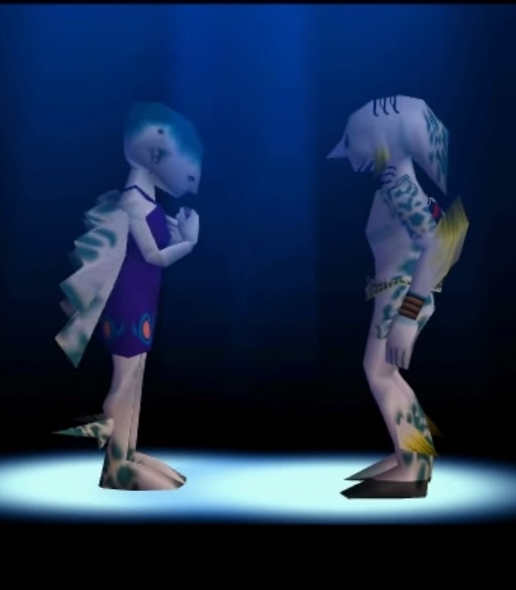“If You Can Truly See Me, Then Follow Behind Me.” Part II of III Examining the Song of Healing
Posted on February 03 2015 by Aaron Suduiko

Today on With a Terrible Fate, I analyze the tragedies of Darmani and Mikau, and offer an explanation of why Link is uniquely able to help them.
(Disclaimer: this series is a work of theoretical analysis, which offers interpretations that are often outside of canon, and is not concerned with authorial intent. I hope that my work might all the same prove itself to be useful and enjoyable.)
In the first part of With a Terrible Fate‘s series on the Song of Healing, I argued that the Song of Healing, despite being described by the Happy Mask Salesman as “a melody that heals evil magic and troubled spirits,” is most parsimoniously understood as an intermediary tool between states of community and states of solitude. I emphasized that the neutrality of this model was useful because it cohered with the thesis of metaethical nihilism with which we have been working since the beginning of this project; we will soon consider how moral valence might interact with this mechanism, but that exploration will follow the metaphysical analysis currently at hand. I began this three-part analysis by considering the Song of Healing as it functions as a transitional mechanism from a state of community to a state of individuation, as in the case of Deku Link and Pamela’s Father; in this second part of the analysis, I want to examine how it functions when the directionality is reversed, and it returns an individual to a particular community. Though I mentioned that the case of Kamaro falls into this category, I want to focus on the instances of Darmani and Mikau, for their cases are more directly pertinent to the structure of the narrative in “Majora’s Mask” than Kamaro’s is.

When Link arrives at the frigid mountain of Snowhead, Kaepora Gaebora leads him to the Lens of Truth, a magical artifact that allows him to perceive things that would otherwise be invisible. By using the Lens, Link is able to see the ghost of Darmani: “If you can truly see me,” Darmani says to him, “then follow behind me.” Darmani leads Link to his grave, where he laments that he perished while trying to free Snowhead from the “demon” of the Giant bound by the magic of Majora. Darmani begs Link to bring him back to life so that he can save his village; or, barring that, to heal his sorrows. Link then plays the Song of Healing, triggering a sequence in which Darmani sees himself applauded by his fellow Gorons; Darmani’s spirit then passes on, leaving Link with the Goron Mask and the charge to help his Goron Village.

Link encounters Mikau in similar-yet-distinct circumstances at the Great Bay, as I described previously in a discourse on the significance of death. Though Mikau is not a ghost when Link finds him, his death is imminent, with Link being the only one to bear witness; Link is also the only one who can bury Mikau, and heal his pain with the Song of Healing. When he plays the song, Mikau undergoes a sequence in which he sees himself reunited with Lulu, the singer of the Indigo-Go’s; they then walk towards the other members of their band, hand-in-hand, as the vision fades out and Mikau fades away, leaving only the Zora Mask and a charge to help Lulu (“that singer girl”).
In both of these scenarios, as I mentioned last time, the healing sequence triggered by the Song of Time involves a return of the suffering individual to the community they died trying to save — Darmani tried and failed to save his village, and Mikau tried and failed to save the eggs of Lulu from the band of Gerudo Pirates that stole them. Importantly, in both cases, Link learns how to use the different features of the masks synthesized by the Song of Healing by reading the inscriptions of the fallen heroes’ graves. This mechanic establishes a sense of heritage: both Darmani and Mikau are passing on their histories to Link, effectively initiating him into their respective lineages.
The concept of inheritance, at first blush, is a clean way to parse how the Song of Healing functions in these scenes: Link is carrying on the tradition of the Goron and Zora heroes, saving their people as the heir to the mantle of heroism. Yet the relationship between Link, Darmani, and Mikau is more complex than this, because Gorons and Zoras do not perceive Goron Link and Zora Link as descendants of their heroes; rather, they believe Link to literally be Darmani or Mikau. In the case of the Gorons, this causes confusion due to their belief that Darmani was dead, leading them to think that a miracle of some sort has occurred; in the case of the Zoras, this arguably precludes them from ever realizing that Mikau has actually died. What does this conflation of Link’s identity with the identity of local fallen heroes imply? I submit that there are two major consequences, which I enumerate below.
1. The intra-timeline agency afforded by Termina to Link is hyper-protected, yet dependent on a relation to Termina’s native heroes. We have begun to articulate a refined thesis of Link’s capacity to exert agency within any given three-day cycle (i.e., timeline) of Termina; one implication in the background of this thesis, which I haven’t yet discussed, is that this capacity to exert agency is in fact limited to Link. This is obvious on an intuitive level, because Link is the sole character within the domain of the player’s control; yet this notion is also narratologically recapitulated by the relationship between Link and Termina’s native heroes. Darmani and Mikau, as entities constrained to the apocalyptic framework of Termina, cannot independently succeed in advancing Termina towards the eventual defeat of Skull Kid; yet Link, whom we have already framed as a stranger in the alternate universe of Termina, cannot employ his agency within Termina without adopting the personas of the heroes who actually had a stake in saving the dying world. What the Song of Healing does in these cases is to transform the relationship that Darmani and Mikau bear to Termina by establishing a connection between them and Link, the only source of agency within the universe. We can use this paradigm to understand the association between the healing sequences of Darmani and Mikau, and the Masks that are left behind thereafter: Darmani and Mikau perished in an effort to save their communities, and, in that act, they were fatalistically separated from their community by the veil of death; yet Link’s use of the Song of Healing allows him to don the guise of Darmani and Mikau and, using his own capacity of agency, to actualize the will of the fallen heroes by saving their communities. So the thing meaningfully transmitted from the fallen individuals to their communities by the Song of Healing is their heroic will: Link’s unique metaphysical freedom allows him to make a reality of what Darmani and Mikau were deterministically prevented from achieving.
2. The macroscopic framework of the “Zelda” series can be collated using the same paradigm of transmitting the individual to the community. In the same vein that I argued a meta-thesis about video games was derivable from the ‘community-to-individual’ direction of the Song of Healing, I submit we can extract a meta-thesis from the ‘individual-to-community’ direction. Specifically, I think that this provides a useful means of answering the following question: given that the “Legend of Zelda” series encompasses innumerable timelines, multiple ages, and multiple Links, how do we synthesize the stories of each game into a collective narrative? While I certainly would not argue this to be the only response to that problem, I think a viable means of response is to point to the agency employed by the player in taking up the story of each particular Link, and, in so doing, experientially unifying them. What I mean is this: in spite of existing across various timelines and worlds, “Zelda” games maintain certain fixed points — for example, the Triforce, some incarnation of Demise (typically Ganondorf), Zelda, and Link. Though I have argued that many of these fixed points do not obtain in “Majora,” one that always does, by virtue of being the player’s direct connection to the universe of the game, is Link. What allows any particular Link to undertake his quest to save his particular community is the player of the game, and it is this dynamic that is identical to the functionality of the Song of Healing in this direction: suppose Link, as an avatar, to be like a ‘mask’; you, the player controlling Link, are constant as the source of agency acting upon the game, even as each Link you control is distinct. Thus, this paradigm endows the player with unique significance in fundamentally being the unifying thread of the series as a whole.

What is at stake when the Song of Healing sounds, and Mikau faces Lulu in a vision that will never come to pass? The people wrenched apart by the inescapable apocalypse of Termina can never escape the universe of fate, but Link possesses a unique gift to offer them: the agency to redeem their will and love of their community, in spite of their fate. The Song of Healing in this direction extends the freedom of Link to the bound heroes of Termina, a special interaction predicated upon the special metaphysics of “Majora”: by truly seeing Darmani and Mikau, Link is able to translate their will into action. This, of course, remains an analysis that has been sanitized of moral valence — and it is towards this question of morality that I will turn in Part III of this series.
Want to follow the analysis and theory? Read on at With a Terrible Fate.
Aaron Suduiko, Phillips Exeter Academy ’13, Harvard University ’17. Studies philosophy with a focus on developing new aesthetic theory with a grounding in the medium of video games. In 2013, he conducted a comparative analysis of role playing paradigms in video games (“Legend of Zelda: Majora’s Mask,” “Nier,” “Dishonored,” and “Deus Ex: Human Revolution”) and plays (“Six Characters in Search of an Author,” “The Man in the Iron Mask,” “Macbeth,” and “Flowers for Algernon.” He is the author of “With a Terrible Fate,”a twice-weekly analysis of “Majora’s Mask” that is published by Zelda Dungeon and is set to continue through the release of the 3D remake this coming spring. Suduiko is reachable at withaterriblefate@gmail.com.



